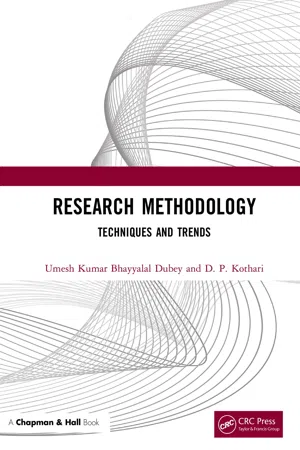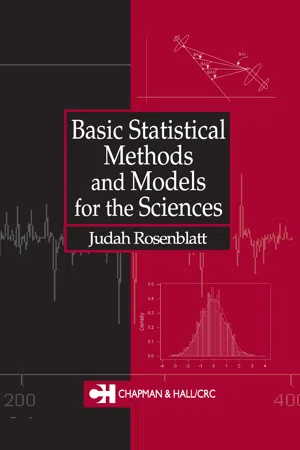Psychology
Population Samples
Population samples refer to a subset of individuals selected from a larger group, or population, to represent the characteristics of that population. In psychology, researchers use population samples to draw conclusions about the broader population based on the characteristics and behaviors of the sample. The goal is to ensure that the sample is representative of the population to make valid inferences.
Written by Perlego with AI-assistance
Related key terms
9 Key excerpts on "Population Samples"
- eBook - ePub
Research Methods in Applied Settings
An Integrated Approach to Design and Analysis, Third Edition
- Jeffrey A. Gliner, George A. Morgan, Nancy L. Leech(Authors)
- 2016(Publication Date)
- Routledge(Publisher)
9 Sampling and Introduction to External Validity
DOI: 10.4324/9781315723082-9What Is Sampling?
Sampling is the process of selecting part of a larger group of participants with the intent of generalizing from the sample (the smaller group) to the population (the larger group). To make valid inferences about the population, we must select the sample so that it is representative of the total population.Sample General term for the selected part of a larger group of potential participants taken with the intent of generalizing from the smaller group or sample to the theoretical population.Population The larger group of interest for the study and from which the sample is drawn.Political pollsters and market researchers have developed and refined the process of sampling so that they are usually able to estimate quite accurately the voting or purchasing intentions of the population of the United States from samples as small as several hundred participants. We are all familiar with public opinion and voting surveys, usually done by telephone interviewers who may use random-digit dialing techniques to select the persons whom they choose to call. If the questions are clear and the participants answer them truthfully and accurately, a random sample of approximately 1,000 participants is enough to predict, within ±3 percent, what the whole population of the United States would say or feel about a certain issue.You may be familiar with the Nielsen television ratings, which are based on information gathered about the TV viewing of a few thousand representative households. These ratings are then extrapolated to indicate the percentage of the total TV viewing population of the United States that would have watched a certain show, and this determines advertising rates. A similar Nielsen system was developed to assess the specific shopping behaviors of a sample of American consumers who actually scanned the bar codes on the items they purchased so that Nielsen could report information to manufacturers not only about the number and types of items purchased but, perhaps more importantly, also about profiles of the people who were doing the buying. - eBook - ePub
Research Methodology
Techniques and Trends
- Umesh Kumar B Dubey, D P Kothari(Authors)
- 2022(Publication Date)
- Chapman and Hall/CRC(Publisher)
The unit about which information is collected is called as an element. According to a well-defined procedure this provides the basis for analysis. Elements should be well defined and the possibility of identifying them physically is important. For example, in a retail stores survey, a shop may be considered as a unit, whereas in a family budget enquiry a household may be treated as a unit.6.2.2 Population or Universe
Population is the entire aggregation of items from which samples can be drawn. A population is a group of individual persons, objects, items, or any other units from which samples are taken for measurement. Pertaining to a given characteristic, population is a well-defined setup of all elements. It refers to the whole that includes all observations or measurements of a given characteristic. Population is also called universe. It may be defined as any identifiable and well-specified group of individuals.For example, all primary school teachers, number of all college teachers, and all university students. A population may be finite or infinite. A finite population is one where all the members can be easily counted. An infinite population is one whose size is unlimited, and cannot be counted easily. For example, the population of college teachers, school teachers, family members, etc., are examples of finite population and the number of stars in the sky, the number of fishes in the sea, etc., are examples of infinite population.6.2.3 Sample and Sampling
A part of the population is a sample. It can be an individual element or a group of elements selected from the population. Although sample is a subset, it is representative of the population. Sample is suitable for research in terms of cost, convenience, and time. Based on a probability or a nonprobability approach the sample group can be selected. A sample usually consists of various units of the population. The size of the sample is represented by “n - eBook - ePub
- John DeLamater, Jessica Collett(Authors)
- 2018(Publication Date)
- Routledge(Publisher)
It would be virtually impossible—and enormously expensive—to interview all people in the population of White adults, so the researcher instead selects a sample, or representative subset, from that population to interview. Sample selection is one of the most important aspects of any type of survey. In some cases, investigators may use a particular sample simply because it is readily available; samples of this type are known as convenience samples. A sample consisting of students taking a class, occasionally used in social science research, is a convenience sample. Convenience samples have a major drawback—they usually lack external validity and do not enable the investigator to generalize the findings to any larger population. For this reason, it is better research practice to select some other type of sample—one that is representative of the underlying population. Only when the sample is representative can the results obtained from it (for example, information regarding racial prejudice obtained from survey respondents) be generalized to the entire population. The nature of the sample, therefore, has a major impact on the external validity of the survey. Two types of systematic samples are commonly used in social psychological surveys. One is the simple random sample, wherein the researcher selects units—usually individuals—from the population such that every unit has an equal probability of being included. To use this technique, the researcher needs a complete list of members of the population. At a university, for example, they might obtain a list of all students from the registrar. At the city or county level, they might use voter registration lists. A frequent problem, especially when the population being studied is large, is the absence of a complete list. Under these circumstances, researchers usually fall back on some substitute, such as a telephone directory - eBook - ePub
Researching Health Needs
A Community-Based Approach
- Judy Payne(Author)
- 1999(Publication Date)
- SAGE Publications Ltd(Publisher)
population. A sample is a smaller sub-set of all the possible people who might be included. If it is a properly selected sample it will be representative of the total population of people (or households) who make up your community. Sample size is discussed later in this chapter.The best way to get a representative sample is to pick people or households in a way that prevents the person doing the selection having any say in who gets drawn, rather like the National Lottery draw. This is called random sampling, the word ‘random’ being a technical term meaning that the selection is not biased to over-represent any one group. Sometimes random sampling is referred to as probability sampling. This is because, in the process of selection, everyone has an equal (in simple random sampling) or known (in stratified sampling) chance or probability of being selected. If you are undertaking quantitative research, provided you have a random sample, it is possible to do statistical analysis on the data you collect.The overall answers you obtain from a good sample will be very close indeed to the answers you would have obtained if you had questioned everybody. It is true that the sample’s answers are only estimates, and you need to remember this in reporting what you find out. However, if all aspects of the research are properly carried out, the estimates based on the sample will be very close to what the whole population would say. With a random sample, you can calculate just how close by using confidence levels: research reports sometimes say things like ‘The proportion saying they visited their GP in the last year was 45 per cent, plus or minus 2 per cent’. What this means is that the researchers know that 45 per cent of the sample did it, and it can be estimated that between 43 per cent and 47 per cent of the population did it. Confidence levels are discussed in Chapter 9 - eBook - ePub
Statistics: An Introduction: Teach Yourself
The Easy Way to Learn Stats
- Alan Graham(Author)
- 2017(Publication Date)
- Teach Yourself(Publisher)
N, is known as a ‘census’.Random samplingThe tale of Keith Parchment illustrates two very important features of sampling. First, if a sample is too small it may not provide a very reliable or representative cross-section of the population as a whole and indeed may give a wrong impression of it. Second, there is the other side to this coin, namely that large samples, although they may be highly representative and accurately reflect the population, are usually also very expensive and time-consuming to carry out. In practical terms, therefore, sampling is always a compromise between accuracy on the one hand and cost on the other.A random sample is one in which every item in the population is equally likely to be chosen.There are several techniques for choosing a representative sample, of which probably the best known is random sampling. Its basic definition is as follows.With random sampling, there also needs to be some sort of random-generating process used to select each item. Suppose, for example, we wished to select a sample of size 50 (sample size, n = 50) from a population consisting of a sampling frame of size 1000 (i.e. N = 1000). The usual approach would be to allocate a number to each item in the sampling frame (from 1 to 1000 or perhaps from 0 to 999) and then find some way of randomly generating 50 numbers from within this range. The population items which had been allocated these numbers then become the 50 items which form our sample.There are two common methods of random sampling – sampling with replacement and without replacement. Replacement means simply putting an item back into the sampling frame after it has been selected. Although replacement is sometimes thought of as being a more correct form of random sampling, in most practical sampling situations items are not replaced after they have been selected. - Michael R. Chernick(Author)
- 2011(Publication Date)
- Wiley(Publisher)
population refers to a collection of people, animals, or objects that we are interested in studying. Usually, there is some common characteristic about this population that interests us. For example, the population could be the set of all Americans having type II diabetes. A sample would be a subset of this population that is used to draw inferences about the population. In this example, we might have a drug like metformin that we think will control the sugar levels for these patients. There may be millions of Americans that have type II diabetes.But we shall draw inference about the population based on a sample of 1000 subjects with type II diabetes that we were able to enroll in a clinical trial. If the trial is properly conducted statistically, we may estimate a treatment effect in the population based on an estimate from the sample of 1000 subjects in the trial. This estimate, if favorable, may lead the FDA to approve the drug for treatment of type II diabetes to any American with type II diabetes.Without a proper statistical design and analysis, the inference to the population would not be valid and would not lead to an approval even if the results are positive for the sample. The sample estimate could be biased, and the probability that a decision favors the conclusion of effectiveness when the drug is really not effective (called the type I error or significance level) would not be appropriately controlled.So to summarize, a population is a collection of things or people that have similarities and possibly subgroup differences that you are interested in learning about. A sample is simply a subset of the population that you take measurements on to draw inferences about those measurements for the population the sample was taken from.2.2 SIMPLE RANDOM SAMPLINGOne of the easiest and most convenient ways to take a sample that allows statistical inference is by taking a simple random sample. As mentioned earlier, many methods of sampling can create biases. Simple random sampling assures us that sample estimates like the arithmetic mean are unbiased.Simple random sampling involves selecting a sample of size n from a population of size N . The number of possible ways to draw a sample of size n out of a population of size N is the binomial coefficient (read as “combinations of N choose n ”), the number of combinations of N things taken n at a time. This is known in combinatorial mathematics to be N !/[n !(N – n )!]. By “n !”, we mean the product n (n − 1) (n − 2) … 3 2 1. In simple random sampling, we make the selection probability the same for each possible choice for the sample n . So the probability that any particular set occurs is- Judah Rosenblatt(Author)
- 2017(Publication Date)
- Chapman and Hall/CRC(Publisher)
Chapter 3 Sampling and Descriptive Statistics 3.1 Representative and Random Samples Much of the data that we gather to gain information can be thought of as a sample from some larger collection of objects — which we will refer to as the target population. 1 When we sample from such a population we would like the sample to be representative for some attribute. By this we mean that we want the proportion of objects in the sample with this attribute be close to the proportion of the population 2 with this attribute — because it is usually the population proportion with the given attribute that is of interest. For instance, just recently we had good reason to believe that our dog (a not too discriminating greyhound) had eaten an entire container of Tums (this is the same dog that chewed a full tube of crazy glue). The veterinarian took a sample of his blood. Unless this sample’s proportion of calcium (the main ingredient in Tums) was likely to be close to the proportion of calcium in his entire bloodstream, it might be difficult to decide on the proper treatment- eBook - ePub
- Diana Mutz(Author)
- 2011(Publication Date)
- Princeton University Press(Publisher)
Chapter 6 , the structure of ongoing Internet panels makes re-contact easier and less expensive, and thus entirely plausible in the context of population-based survey experiments.Participants
Population-based survey experiments have obvious advantages in terms of the generalizability of the sample population. This is the dimension on which population-based survey experiments win the external validity contest hands-down. The diversity of samples available through surveys means that population-based experiments can address generalizability across different segments of the population, far beyond college sophomores, to many educational and economic groups within the population.But the advantages do not end with generalizability to the full population of interest. The subjects in a population-based experiment can be representative of just about any group to which the researcher desires to generalize. They can easily transcend local geography, and allow us to test theories on precisely those groups to which we expect the theories to generalize.Does this matter? Opinions differ, but it certainly does not hurt. Sometimes, as in the studies of jealousy described in Chapter 3 , there are logical reasons to question the generalizability of findings from student samples in particular; in other cases, it is unclear whether it should matter or not. Whether findings will be different is likely to vary by the topic and process under study. My own view is that there are very few areas of social science in which we can safely assume (without any empirical evidence) that findings based on students are generalizable to other populations. There are some, to be sure. But there are far more examples in which it was prematurely assumed that a finding based on college students was a good approximation of what would be found outside the student context. In a study of consumer behavior, for example, non-college student subjects generated effect sizes that were, on average, 42 percent higher than college student samples.33 Others have experienced failures to replicate across student and non-student populations.34 In economic experiments using the dictator game, for example, community members donated significantly more money on average than students.35 - eBook - ePub
Quantitative Research Methods in Communication
The Power of Numbers for Social Justice
- Erica Scharrer, Srividya Ramasubramanian(Authors)
- 2021(Publication Date)
- Routledge(Publisher)
n or sample size is the denominator in the standard error equation. Given that generalizability is one of the hallmarks of quantitative research, reducing sampling error is an important outcome.Second, we should remember that the variation in the population parameter is also an important part of the standard error equation, and when the parameter has less variation, sampling error will also be reduced. Therefore, you will need a larger sample size to attempt to reflect the population on an item with significant variation, and a relatively smaller sample size will suffice if the population is more homogeneous on the issue in question.Third, researchers can determine—oftentimes prior to conducting a study—how much uncertainty they are willing to live with regarding whether the results that they obtain from a sample are likely to generalize to the population. When researchers obtain a result from a sample (a statistic), ideally, they would like to be confident that that result happened not just due to sampling error or some kind of chance circumstance in the sample but rather is likely to be operating not just in the sample but in the wider population. Confidence intervals are used to make these wider claims within widely accepted standards among researchers regarding how much uncertainty is acceptable.Representing Minoritized Groups
We have seen that there are many virtues of using probability sampling. Yet, sometimes, a researcher will want to focus on a subpopulation of interest that is relatively small in size compared to the overall population. A probability sampling strategy in which every member of the population has an equal chance of being selected may not yield a sufficient number from the small subpopulation of interest to fully explore variables within that subpopulation. Therefore, some additional strategies are needed.
Learn about this page
Index pages curate the most relevant extracts from our library of academic textbooks. They’ve been created using an in-house natural language model (NLM), each adding context and meaning to key research topics.








